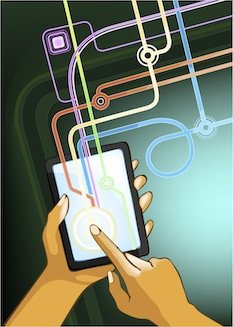How do you engage readers? Self-published author Michael La Ronn, from Iowa, USA, shares his positive experience of writing interactive fiction.
Last year, I stumbled across an answer when I reread my favourite Choose Your Own Adventure novel.
If you were a kid like me in the 80s or 90s, it was hard not to like Choose Your Own Adventures. They invited you into an exciting, dangerous world where you, the reader, had to make decisions that meant life or death. They were interactive fiction at its finest.
It was fun to relive my childhood, but I wanted more. I’m an adult now, and my reading tastes have changed. I wanted an interactive reading experience, but with grown-up characters and storytelling.
I didn’t see a novel like this in the marketplace, so I wrote one: How To Be Bad.
What is Interactive Fiction?
Interactive fiction has one major distinction: at certain intervals, the reader is presented with choices that determine how the novel continues. The novel then forks into many different paths, each with more choices, and there are several endings.
The genre didn’t catch on with older audiences because they viewed it as gimmicky – for good reason. They also resisted the genre’s infamous second person POV (point of view).
Re-Engineering a Genre
I dislike gimmicks, too, so I approached the genre differently. I eliminated what didn’t work: false endings, second person POV, and shallow storylines. I ditched print books altogether and formatted my book specifically for e-readers and tablets.
When I applied the rules of craft (good characters, plot, etc.), I had something that felt fresh yet familiar. More importantly, I had found a viable way to engage my readers.
Here’s how:
- Reader immersion Readers don’t just read an interactive novel; they participate. My novel is about a woman who accidentally makes a deal with a demon and must steal three innocent souls to break the contract. If she doesn’t, the demon will take soul of the man she loves. She (e.g. the reader) has to make increasingly unethical decisions, and when it’s over, the reader shares in her successes (and her failures).
- Enhanced storytelling I like to imagine my heroine as a darkened portrait. Every decision the reader makes illuminates a section of the portrait that another decision can’t. The reader doesn’t see the whole picture immediately, but when they do, it’s a complex image—one that grows richer with subsequent rereads.
- Built-in engagement My heroine has several arcs, all equally viable and satisfying in their own right. Because of this, every reader experiences the story differently, and the novel becomes something different to each person. Combined with the ethical theme of the novel, this becomes a vehicle for discussion. (“Hey, what did you choose in Chapter 5?”, or “What did you think about the ending where…”)
I discovered other cool things along the way.
But imagine the possibilities. Imagine a mystery where the reader solves the murder, or a fast-paced thriller where the decisions determine the fate of the world, or a romance where the geeky heroine’s decisions affect whether she finds love. Anything is possible in the hands of a good writer.
It’s worth mentioning, too, that the genre is especially suited for reading devices, which makes it an easier sell if it is well-written and engaging.
Of course, I’m not saying that interactive fiction should replace traditional fiction, but they contrast with each other in interesting ways.
Self-published authors are in the best position of all to take advantage of this uncrowded genre because publishers haven’t caught on to its potential. It’s a lot of fun, and you might be surprised at how readers can react – or interact – with this type of book!
Find out more about Michael La Ronn's interactive novel, How To Be Bad, at his website here: www.michaellaronn.com.
For further information about the original concept of interactive fiction, read Wikipedia's profile of Choose Your Own Adventure Stories








[…] Self-published author Michael La Ronn shares his experience of writing interactive fiction for the modern adult reader – and his enthusiasm for reaching readers this way. — Read on selfpublishingadvice.org/writing-interactive-fiction-with-michael-la-ronn/ […]
[…] A recent post by Michael La Ronn, posted on Self Publishing Advice, reminded me of this. Michael wanted an interactive reading experience, but with grown-up characters and storytelling. Since he didn’t see a novel like this in the marketplace, he wrote one: How To Be Bad. […]